#only assisi
Text
i assume everyone knows what/where assisi is because my mom is a obsessed with saint francis and would drag us on pilgrimages there since we were like one years old. and like i talk about going to assisi and they are like "a see what?" nvrmnd i thought this was normal.
#ive been there 5 times#if that gives you any indication of how obsessed my mother was#its her mecca and i say this with all sincerity#its like a religious obligation for her#she does not care about jerusalem#only assisi
83 notes
·
View notes
Text

horse being showered with holy water by a man of the christian church which we can deduce is likely a catholic church due to the relief of a crucifix a symbol only typically used by catholics behind the priest however it seems this crucifix is either unfinished or only of the severed torso of jesus christ which is an interesting design choice if it is purposeful this horse has been welcomed into the catholic church likely on october fourth the feast day of saint francis of assisi who is the patron saint of animals which are oftentimes welcomed into catholic churches on this day to receive blessings in his honor while most catholics and many christians tend to believe that animals dont have souls it is beautiful to see them make an effort to include animals in their masses because despite believing this animal will not go to heaven with them they want the animal to be blessed by their god while they are with it and isnt welcoming all the children of the earth to share in what you hold dear is the most religious thing to do of all
#horse#horses#horse pics#horseblr#horseposting#reaction pics#reaction image#reaction images#christianity#catholic#catholicism#religion#singular horse#indoors#neighhhh
303 notes
·
View notes
Text

A US Consolidated B24 Liberator makes an emergency landing in a field near Eindhoven after being hit by flak during Operation Market Garden - Sept 1944. Only gunner Frank DiPalma survived. He was rescued from the wreckage by Franciscan monks who hid him in the village of Huize Assisi until its liberation by the British
#world war two#1940s#worldwar2photos#history#ww2#ww2 history#wwii#world war 2#wwii era#ww2history#b 24 liberator#b24#b 24#b24liberator#USAAF#us air force#1944#operation market garden#eindhoven
378 notes
·
View notes
Text
Time Travel Question 55: Medievalish and Earlier
If you could travel through time, but only to see something for Research or for Fun, not to change anything, what would you pick? Yes, you may have a Babel Fish in your ear to translate.
These Questions are the result of suggestions a the previous iteration. This category may include suggestions made too late to fall into the correct earlier time grouping. In some cases a culture lasted a really long time and I grouped them by whether it was likely the later or earlier grouping made the most sense with the information I had.
Please add new suggestions below if you have them for future consideration. All cultures and time periods welcome.
#Time Travel#Middle Ages#Basilica of Saint Francis of Assisi#Art History#Italian History#Cimabue#Giotto#Simone Martini#Pietro Lorenzetti#Pietro Cavallini#lithophones#History of Music#Homins#Prehistory#Minoans#mythology#Minoan mythology#Ancient Greece#Ancient Rome#Roman Religion#Ötzi#Ötzi the Ice Man#Neanderthal#Neanderthals#Fashion History#Folklore#History of Food
80 notes
·
View notes
Note
Do you happen to have any resources on mysticism? I’m writing a short paper for one of my classes, and I want to bring in some outside sources <3
depends on what branch/type! i'm the most well-versed on Catholic mysticism, of course. so, that's what i'll share.
i illustrated Shannon K. Evans' new book: "The Mystics Would Like a Word." (out now!) It's about St. Thérèse of Lisieux, St. Catherine of Siena, St Teresa of Ávila, St. Hildegard of Bingen, Julian of Norwich and Margery Kempe. i think it's a brilliant intro to mysticism that also ties the practice to modern day. besides, these women are the quintessential mystic girlies within Catholicism, so you could look into them.
For St. Thérèse specifically, you could look into her autobiography, 'Story of A Soul'. For St. Teresa of Ávila, it could be 'The Interior Castle.' For Julian of Norwich, 'Revelations of Divine Love.' For St. Hildegard, her Scivias or her songs... etc. etc.
a dear buddy, W, has the podcast 'St. Anthony's Tongue" and it specializes in this topic particularly. i'd definitely recommend looking through his podcast and show notes.
since it's a small paper, you might find good sticking to a single mystic. mysticism is so so broad and found across many spiritualities, approaches, religions and cultures. you could also compare and contrast the experiences of two different mystics.
for "lesser-known" mystics, i think St. Gemma Galgani's or Sor Juana Inés de la Cruz' experiences could also be a fascinating subject for essays on mysticism.
(i'm too much of a lesbian to mention men who were mystics. they are uninteresting, in my opinion. the only ones i think i like are St. Francis of Assisi and, in small doses, St. Ignatius of Loyola)
if you need any sources that are even more specialized later on, let me know! i'd be happy to help! best of luck!!!!!!
25 notes
·
View notes
Text
As important as it is to mark the places where we meet God, I worry about what happens when we build a house for God. I am speaking no longer of the temple in Jerusalem but of the house of worship on the corner, where people of faith meet to say their prayers, because saying them together reminds them of who they are better than saying them alone. This is good, and all good things cast shadows. Do we build God a house so that we can choose when to go see God? Do we build God a house in lieu of having God stay at ours? Plus, what happens to the rest of the world when we build four walls—even four gorgeous walls—cap them with a steepled roof, and designate that the House of God? What happens to the riverbanks, the mountaintops, the deserts, and the trees? What happens to the people who never show up in our houses of God?
The people of God are not the only creatures capable of praising God, after all. There are also wolves and seals. There are also wild geese and humpback whales. According to the Bible, even trees can clap their hands. Francis of Assisi loved singing hymns with his brothers and sisters—who included not only Brother Bernard and Sister Clare, but also Brother Sun and Sister Moon. Francis could not have told you the difference between “the sacred” and “the secular” if you had twisted his arm behind his back. He read the world as reverently as he read the Bible. For him, a leper was as kissable as a bishop’s ring, a single bird as much a messenger of God as a cloud full of angels. Francis had no discretion. He did not know where to draw the line between the church and the world. For this reason among others, Francis is remembered as a saint.
Barbara Brown Taylor, An Altar in the World: Finding the Sacred Beneath Our Feet
77 notes
·
View notes
Text
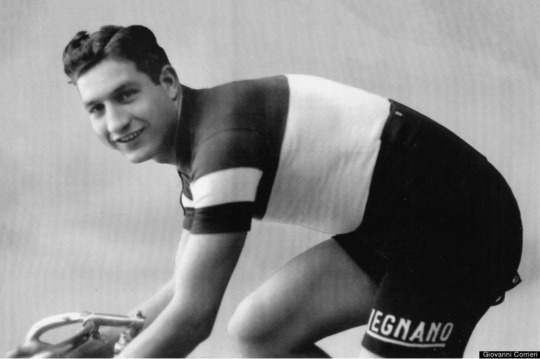
THURSDAY HERO: Gino Bartali
Born in a small town near Florence in 1914, Gino grew up extremely poor. He escaped his difficult life by riding his bike from dusk until dawn around the hills of Tuscany. Building up exceptional strength and endurance, Gino started competing and winning races. Only a few years after his first race, he went professional. By the early 1930’s, Gino was a household name throughout Italy. Everywhere he went he was mobbed by fans. When he won the Tour de France in 1938, at age 24, Gino was hailed as the “King of Cycling.”
Gino wasn’t able to defend his title at the 1939 Tour because of worsening relations between Italy and France. He was drafted into the army and worked as a military bike messenger. In 1943, Germany invaded Italy and immediately began rounding up and deporting Italian Jews. A friend of Gino’s asked him to help save their Jewish brethren. Though married and with a young son, Gino did not hesitate. He immediately committed to doing whatever he could to save lives, whatever the risk.
Gino sheltered a local Jewish family in an apartment he bought with cycling money. He then embarked on a dangerous mission smuggling fake identity papers around Tuscany and Umbria, enabling Jews to assume false identities and escape deportation. Using his training routes between Florence and Assisi, Gino made 30-40 trips, saving at least 800 Italian Jews. He carried exit visas in his bicycle frame. Wherever he went, Gino was surrounded by fans, preventing German policemen from looking too closely at what he was doing. On the few occasions he was stopped and searched, Gino insisted that his specially-made bike was too delicate to be touched. A devout Catholic, Gino often traveled from Florence to Assisi and back in one day – a 200 km trip. In Assisi, Catholic clergy ran an underground railroad to hide Jews and provided them with Gino’s fake identity documents.
Gino was extremely modest and rarely spoke about his wartime heroism. He once told his son, “If you’re good at a sport, they attach the medals to your shirts and then they shine in a museum. That which is earned by doing good deeds is attached to the soul and shines elsewhere.” It wasn’t until after his death in 2000 that his family began speaking publicly about what Gino had done. In 2013, Gino was honored by Israeli Holocaust Museum Yad Vashem as “Righteous Among the Nations.”
For using his talent and fame to save hundreds of lives, we honor Gino Bartali as this week’s Thursday Hero at Accidental Talmudist.
57 notes
·
View notes
Text
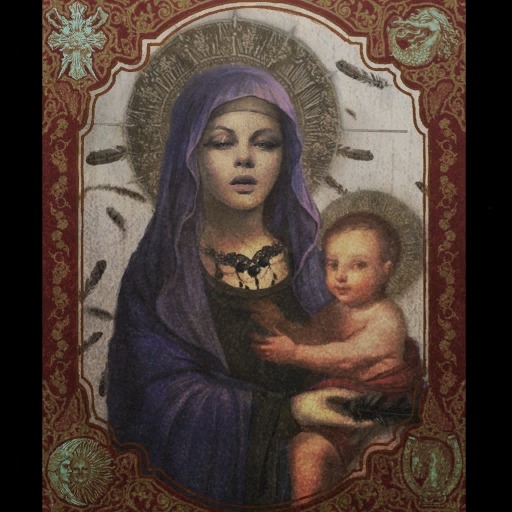


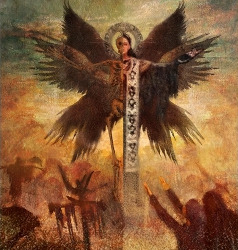

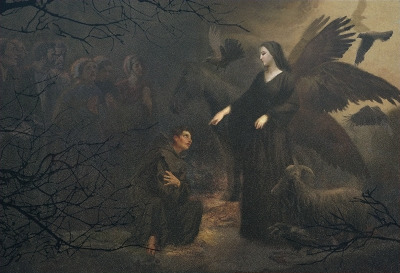
Cultic Iconography in Resident Evil Village
As the kind of nerd who loves all the creepy artwork you can find decorating Miranda-shrines around the village (like, just check out that one of the half-skeletal Miranda hovering in the graveyard and just tell me that isn't metal AF), I was on the lookout for the original image assets while poking through the game files. I'm hardly an expert on Catholic or Orthodox iconography (plenty of which is creepy enough just to begin with), but I adore how you can see all those elements being twisted and appropriated by Miranda's cult. You'll find these six pictures plastered all over the village in various combinations.
So you can imagine how thrilled I was to find a whole extra batch of unused artwork in the same set!




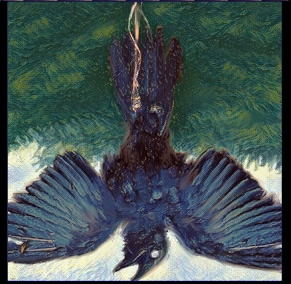
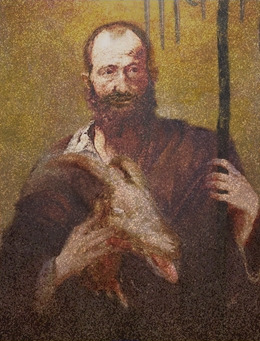
Lest you doubt these were all meant to go together, they all hail from the one big compilation file ‒ I've just cropped them out separately for ease of viewing. For all I know, maybe some of these were used somewhere in the game and I just never caught it (and if you have spotted any, please let me know!)
But taken at face value, our unused images consist of one picture of the megamycete, a 10-winged-madonna figure (why limit yourself to just 6?), a side profile of Miranda herself (possibly excluded because it shows off a little too much of her real face?), two images of dead crows, and (strangest of all) a man holding a goat head.
That last pic especially stands out ‒ and not just because I could (and, indeed, now have) legit write you a whole essay on just the significance of the goat's head motif as a protective symbol in the village (seriously, it's everywhere from the Goats of Warding to the symbol on the shield of the Maiden of War statue), so I'm going to be all over any new example. But who the hell is that guy carrying it? No other image centers anyone but Miranda herself as an object of worship. This looks more like someone's taken a generic pic of the likes of St Francis of Assisi hanging out with some animals (it's a theme, you can look it up), then just cut the poor animal off at the neck for added creep factor.
So do we take it that this guy was, at some point, meant to be another key figure in Miranda's cult? Or was generic-saint-with-animal-plus-extra-squick all they were really going for? Was it drawn before the writers made Miranda the cult leader? Or could this even have been intended (as the goats themselves seem to be) as some in-universe, pre-Miranda relic of an earlier era?

Also interesting: he appears to be holding one of those ornate staves you can also see in the fire and skeletal images of Miranda above (and can also find in the field near Luisa's early in the game, before they're all replaced by charred, semi-crucified corpses). Did that symbol predate Miranda too? Fascinating, either way.
Those two crow pictures may be even more intriguing still. I'm sure we all remember that spooky batch of dead and/or hanging crows Ethan discovers at the start of his descent into the village, but thereafter nothing like that is ever seen again. Given that Miranda herself is so closely associated with crows, it's reasonable to wonder if this very-literal murder-of-crows was in fact some act of heresy by an unbeliever, deliberately hidden out in the woods.

But if images of dead crows ‒ including one hung in the very same position ‒ were at some point intended to appear alongside other images of Miranda-veneration, then presumably veneration was always the intent for those dead crows out in the woods. Suffering is, of course, a key part of the stories of so many saints. And perhaps crows are sacred only in the same way that the goats are: ideal candidates for ritual sacrifice.
Much as I love all the concept art you can already unlock with the game, I'd pay good money for a proper artbook going into all this kind of design work. There's clearly so much more that went into the concept art stages of this game that I'd love to hear more about.
And while we're at it, here's a nice big version of the standard winged-fetus symbol too:
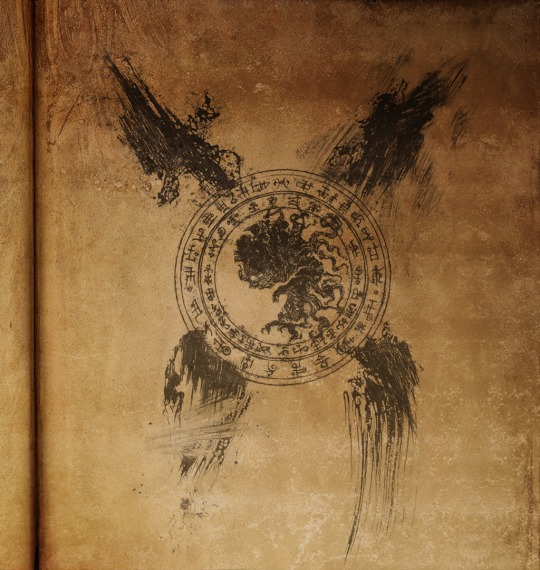
168 notes
·
View notes
Text

Bleach | Dream/Hob | 1067 words | rated G
for @domaystic day 07: stained clothes
tags: retired Dream, laundry mishaps, tooth rotting fluff, religious Hob Gadling (but only incidentally), Dream is learning how to human, Hob Gadling is a good boyfriend
Hob looks mournfully at the sweater in his hands and gives the spot another little scrub. It’s futile. He knows it’s futile. He’s been doing his own laundry for about a hundred years by now, after all. Still, he rubs halfheartedly at the spot, just one more time. Just in case.
You never know, do you. Miracles still happen. Some of them could be laundry-related miracles, possibly. There’s probably a patron saint of doing the wash. Hob casts his mind wildly back to catechism classes of centuries past. Veronica, maybe? The story with the veil? Or Clare of Assisi – had the Poor Clares been laundresses or is he thinking of a different order? He sighs and offers a quick prayer to both of them. Just in case.
He may not have been to church in a month and a half, and he hasn’t been Catholic since the 16th century, but every little bit helps. He sighs again and scrubs at the bleach stain, which doesn’t look back at him accusingly so much as it simply exists, accusingly, on the sleeve of Dream’s softest, most favorite black cardigan.
The front door of their flat bangs open and he hears the jingle of keys and the thump of Dream’s shoes being deposited on the boot tray.
“I’m back! They didn’t have the tea we usually buy,” Dream’s voice calls down the hall. “So I got Barry’s instead. Is that alright? I couldn’t remember if you like that brand or not. Why are there so many kinds of tea, Hob? I stood there looking at the shelf for ten minutes. You’d think at some point humanity would have said, oh, I think we have enough kinds of tea now, but –” he trails off as he begins to put the shopping away, his dear, deep voice disappearing in the rustle of shopping bags and the rattle of cabinet doors.
Hob walks slowly down the hallway from the airing cupboard to the kitchen, sweater held in both hands before him, feeling like nothing so much as a man carrying the body of a beloved pet cat to its owner.
It isn’t that Dream will be angry – far from it, in fact. Dream will be, as he always is, endearingly grateful for the fact that Hob does his laundry, as he is for all the little caretaking tasks that Hob has taken on as Dream learns to be human. It’s just that now, as he learns to be human, Dream’s emotions lie so close to the surface. He feels everything with the depth and intensity of a child: pride when he successfully does the shopping, pain when he stubs a toe or burns a finger on the kettle.
Disappointment, when something goes wrong. Sadness, at a loss or a failure.
Hob has watched him weep over a broken teacup and crow with utter joy after winning a game of cards. And this was his best sweater, his softest, most favorite cardigan, one of the first pieces of clothing that had truly been his. A cardigan Dream had chosen, thoughtfully, in the department store; not just stolen or adopted by osmosis from Hob’s wardrobe. Which now sports an accusing, unmissable bleach stain right on the upper side of the left sleeve.
Dream pauses in his activity when Hob appears in the doorway.
“What’s wrong?” he asks immediately, seeing the look on Hob’s face. “What happened? Are you hurt? I can’t take you to A&E, I’m not allowed to drive the car yet. Hob? What’s wrong?”
“It’s your sweater,” Hob says dismally, holding it up for inspection. “It’s got bleach on it.”
Dream makes an adorable, sad little noise and gathers up the cardigan, cradling it like a wounded animal.
“I don’t know how it happened,” Hob says, not meeting his gaze. “I did that load of towels and socks yesterday, I must’ve spilled some bleach on the edge of the washer when I added it, and I guess the sleeve got dragged through it somehow when I put the colds in this morning, and I am so sorry, love, I know it’s your favorite and I will buy you a new one,” he rushes on, “I will buy you six identical sweaters so this never happens again, I –”
“Hob.”
Dream’s voice can still, at times, attain a certain measure of its former power and gravitas, through mere timbre alone. Hob’s eyes immediately snap up to meet his gaze. Dream’s eyes are huge and blue and watery and human and still the most beautiful thing Hob has ever seen in his long life.
“Hob.” More gently now. “It is just a sweater. Why are you so worried, my love?”
“Well, I mean. It’s not just a sweater. It’s your favorite,” says Hob. “And I want you to, to have nice things. Your favorite things. I know it’s hard, to be human. It’s hard for us normal humans, and I can’t imagine how much harder it is for you sometimes, and I just… I want nice things for you. Because, because I love you,” he says lamely.
Dream looks at him for a long moment, those blue eyes glistening, and then very deliberately casts the cardigan aside onto the pile of shopping bags and steps into the open circle of Hob’s arms.
“My love,” he says tenderly into Hob’s neck. Hob sniffles a little and indulges in the softness of Dream’s hair and the smell of his shampoo. “It is just a sweater. And you may buy me another, even six, if you so wish. And you may stain every single one with bleach, many times over. It will be, as you like to say when I make mistakes, very human of you.”
He pulls back just enough to rub their noses together and murmur his next words into the warm curve of Hob’s mouth.
“I find I like being human, because I am being human with you,” he says. “And you take the best care of me that anyone ever has. And no number of stained sweaters could possibly change that, I am sure.”
“Well then. If you’re sure,” says Hob, and kisses him. “I will get you a new one if you want, though.”
“Or perhaps I will add more bleach stains. And embroidery. And sequins. I have been looking for a new art project.”
“Or that,” says Hob, and kisses him again.
#the sandman#dreamling#domaystic2023#my writing#banged this out tonight in a fit of inspiration#wish that would happen with one of the WIPs I already have on the go
249 notes
·
View notes
Text
Keep a clear eye toward life's end. Do not forget your purpose and destiny as God's creature. What you are in His sight is what you are and nothing more. Remember that when you leave this earth, you can take nothing that you have received...but only what you have given; a full heart enriched by honest service, love, sacrifice, and courage.
St. Francis of Assisi
#catholicism#christianity#works of mercy#spiritual works of mercy#corporal works of mercy#quote#saint quote#st francis of assisi#st francis of assisi quote
95 notes
·
View notes
Text
To a medieval devotee, things are agents and representations; but they are more. They are likenesses ontologically (that is, as what they are). Incense is really like the rising up of a prayer; gold is really like heavenly light or power in more than an arbitrary or simply attributed sense. The veil and crown of a nun do not merely symbolize her virginity; they are her intactness. The flesh of Francis of Assisi is not only nail-like; it has literally become Crucifixion nails, even if Francis, despite being known as the alter Christus, does not become Christ. Although the stigmata of Francis, the bloody wafer of a host-desecration miracle, the tooth of a saint presented in crystal, the nun’s habit, and the gold of a statue’s crown are not “like” the Other of heaven and of God in the same way, they are not simply symbols, icons, or indexes. All are “like” the holy ontologically—that is, in more than an assigned or arbitrary, literal or purely visual sense.
Caroline Walker Bynum, Dissimilar Similitudes: Devotional Objects in Medieval Europe
29 notes
·
View notes
Text
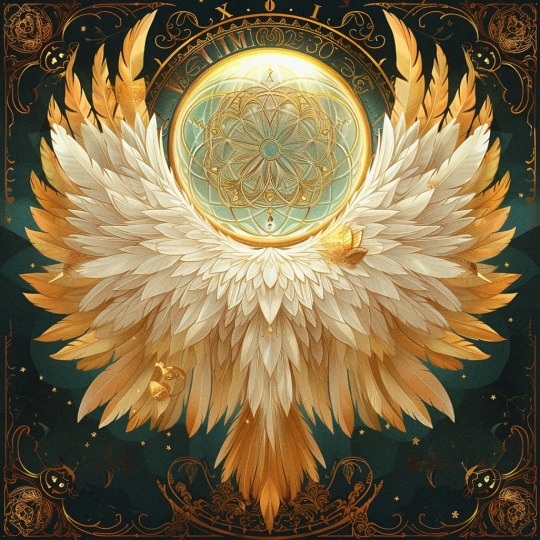
There are three hierarchies of angels each of which contains three orders.
The Nine Choirs of Angels
The Arrangement of the Angels of the Lord (according to Pseudo-Dionysius)
Let’s turn to the individual choirs so that we can examine the powers each have, and how they relate with one another.
Seraphim
The seraphim are the angels closest to God. As such, they reflect most immediately the highest attribute of God manifest in creation: His love. They are on fire with the love of God; the very name means “incandescent ones” or “burning ones.” Classical sacred art portrays them as entirely red and ablaze. They are usually depicted as having six wings but no faces — simply a sea or ring of flame around the Holy Trinity. Because of this burning love, more than any other angel they have the most perfect knowledge of God, which makes them the most perfect adorers. St. Jerome notes that they not only burn by themselves, but they also inflame others with the love of God.
According to the prophet Isaiah, the seraphim are the angels whom he hears crying out “Holy, holy, holy,” as one of them purifies Isaiah’s mouth with a coal from the altar so that he might serve as the Lord’s messenger (Isa. 6:3–8). In the Extraordinary Form of the Roman Mass, the priest evokes this moment as he prays for worthiness in proclaiming the Gospel. We too should pray to the seraphim that we might be purified in our responsibilities as teachers and bearers of the Word to our families, our friends, and all those over whom we have responsibility. It was a seraph who appeared to St. Francis of Assisi when he received the stigmata. Later mystics, too, will speak of the seraphim as the Lord’s messengers and intermediaries when they had extraordinary experiences of loving and transforming divine union.
Cherubim
The cherubim have a deep intellectual knowledge of divine secrets and of the ultimate causes of things; their name means “all-knowing one.” As such, they constantly contemplate the wisdom and the love of God in His relationship with mankind. They reflect His omniscience. The cherubim were the mighty adorers of the first covenant in its wisdom; images of the cherubim were the only images of beings that were permitted in the ancient Temple of Jerusalem. Their carved figures adorned the lid of the Ark of the Covenant, which prefigured both the Virgin Mary “tabernacling” the unborn Christ and the Eucharistic tabernacles of our churches, containing the new manna of Christ’s sacramental Body and Blood. Embroideries of the cherubim also covered the beautiful drapery that separated the Holy of Holies from the outer court of the Temple. It was that veil that was ripped from top to bottom when Our Lord died on the Cross as the sign that He had passed into the Eternal Sanctuary and that the Temple of Jerusalem had fulfilled its purpose (Matt. 27:51). The cherubim are still considered protectors of the New Covenant and so are often depicted on tabernacles and Eucharistic vessels.
Thrones
The thrones, as their name suggests, can be thought of as beings raised up to form the seat of God’s authority and mercy. A throne manifests the glory and authority of a king; it expresses stability and power. And since a throne is also a judgment seat, these angels are especially concerned with divine judgments and ordinances.
In the early Church, a common representation of God’s glory in Heaven was a mosaic behind the altar and above the seat of the bishop that represented an empty throne with a radiant cross mounted above it. This image represented Christ the King, Lord of all and Judge of the living and the dead. But His judgment seat was also a throne of mercy, for Christ has redeemed the world by His Cross. His love has brought us to salvation. The thrones are never seen or experienced as “flying” but as “rolling” across the heavens, in keeping with their manifesting the Lord’s stability.
* * *
The second hierarchy receives knowledge of divine secrets through the first three choirs — knowledge that they could not perceive by themselves. The ardor of the seraphim inflames their love; the wisdom of the cherubim reveals the depth of the mysteries; and the stability of the thrones draws them into constant adoration of God’s majesty. In the Summa Theologiae, St. Thomas teaches that the names “domination,” “power,” and “principality” belong to government in different ways. The place of a lord is to prescribe what is to be done, and so Gregory says that “some companies of the angels, because others are subject to obedience to them, are called dominations.”
Dominations
The dominations are concerned with the government of the universe. They are the first of the three choirs in the second ring, which is the ring of the cosmos — the angels who are charged with great and universal stewardships. The dominations in particular are involved in the workings of divine power. They coordinate the ministries of all the angels who deal with creation. We see in the angelic world that the Church’s teaching that God works through secondary causes is beautifully demonstrated. The angels mediate God’s power just as the saints intercede for us with Him.
Virtues
St. Peter mentions the virtues in his first epistle (3:22), as does St. Paul in his Letter to the Colossians (1:16). The name is in some way a mistranslation or at least a “false cognate,” since this choir of angels does not deal with acquired habits (virtues), but rather exercises innate, raw power over the physical universe. According to Pseudo-Dionysius, their name refers to “a certain powerful and unshakable virility welling forth into all their Godlike energies, . . . mounting upwards in fullness of power to an assimilation with God; never falling away from the divine life through its own weakness, but ascending unwaveringly to the super-essential Virtue which is the Source of virtue.”1 They are the lords of causality and the principles of cosmic order in the material realm. They ensure the well-being of the world.
Powers
The powers (dunameis) form the third and last choir of the second angelic hierarchy, according to Pseudo-Dionysius, while other scholars and spiritual writers consider them to be the fifth choir. This choir is mentioned occasionally in the Old Testament, such as in the book of Daniel where we read, “Bless the Lord, all powers, sing praise to him and highly exalt him for ever” (Dan. 3:39). Some scholars maintain that the name “powers” is also used to indicate angels in general, since it is the Septuagint’s translation of the Hebrew sabaoth. In the New Testament St. Paul writes that there are powers who have remained faithful to God and powers who have fallen away and become part of the empire of Satan (Eph. 6:12). The choir of powers is thought to introduce man to the higher mysteries while repressing the attacks of the “hostile powers” of Hell against the deepest laws of physical creation.
* * *
The third sphere of angels is concerned with Almighty God’s plan of salvation for mankind. It receives from the highest sphere its focus on the immutability of God, which is manifested in creation by the harmonious principles and intelligent organization of the laws of nature, which are upheld by the angels of the second sphere. In turn, the angels of this third sphere pour out their influence on those who have the greatest interaction with us in the ordinary course of things established by God.
Princes or Principalities
The princes are also described as having members who have fallen away and others who have remained faithful. Principalities are the leading choir of the last hierarchy of angels. Their activities are described by Pseudo-Dionysius in this way, “The name of the Celestial Principalities signifies their Godlike princeliness and authoritativeness in an Order which is holy and most fitting to the princely Powers.” They are often seen as being the guardians of nations or peoples; this is why St. Michael is described in the book of Daniel as “the prince of Israel,” who comes to the aid of Gabriel against the demonic prince of Persia. It seems fitting that this first choir in the “ring of salvation” should also look after the spiritual structure of the supernatural life of the Church.
Archangels
This choir is the most known and loved in popular devotion. Among the archangels we find St. Michael, St. Gabriel, and St. Raphael. It is traditionally believed, due to the statements of Raphael in the book of Tobit, that there are only seven archangels.
Three of their names occur in Scripture, and so the Church uses these names in our worship — St. Michael, the prince of the heavenly host and the only one called “archangel” in the Scriptures; St. Gabriel, the messenger of the Incarnation; and St. Raphael, the angel of healing and of medicine.
The names of the other four are not used in our Liturgy, though there are certain churches that preserve these names and make use of them in private devotion, including some Eastern Catholic Churches. Roman Catholics often refer to them as the seven archangels or the seven assisting spirits around the throne of God.
The seven archangels have been regarded from the very beginning as having a special place in God’s plan; their number is often associated with the seven days of the week and the seven sacraments. It is thought that the archangels were outstanding in their fidelity to God, and so in the writings of the saints they are often called archangel princes, an appellation that connotes leadership and authority in the heavenly realm. Many spiritual authors and mystics speak of their special assistance and often attribute other “groups of seven” to their protection or patronage — virtues, gifts of the Holy Spirit, and so on. The archangels are also associated with the protection of nations, dioceses, religious communities, and the mission of the Church.
Angels
The ninth and final choir of angels is composed of those who are most involved with the doings of mankind. These angels are those who are sent out on missions from God and from whom the guardian angels are chosen. The angels who fill up this choir may be the lowest, but they are beloved because the Lord places them at our sides to watch over us and to care for us. They are the ministers of Christ’s love and our protectors. They defend us against harm and temptation. They warn us of impending evil and inspire us to remain faithful to God in prayer.
27 notes
·
View notes
Text

A study of a statue of Saint Francis of Assisi that caught me. I tried an oil painting brush for this, and I used only 3 values.
#art study#saint francis of assisi#black and white#digital painting#digital art#digital illustration#study#digital artist#artists on tumblr#eralacrimae
131 notes
·
View notes
Text

“I went to Italy when I was 23. It was the first time I had left the country or traveled by myself. It was June 2008, and I had just finished doing Spring Awakening on Broadway for two years. Over a week, I visited Assisi, Siena, and Florence before meeting my brother in Rome, following the Rick Steves guidebook to the letter.
On my last day alone, I went to see David at the Accademia Gallery. When you turn the corner, there are rows of other unfinished sculptures by Michelangelo. These figures are so constricted, like they're straining to be released from the marble and fighting for air. I ached just looking at them. But they lead up to this perfect, liberated form. I started crying and wondered, What is it about this naked man that makes me so emotional?
Afterward, I sat in a piazza, journaling, thinking about how nobody here knew or cared about me, and I decided to come out to my brother—who is also named David—the next day. Only my roommate knew I was gay, because he was also my secret boyfriend.
I took the train to Rome, and David and I spent the day as tourists. In the evening, we went to this restaurant called Saby's near our hotel, the Locarno. We were getting pasta, we were getting wine, and I knew that if I didn't tell him right then, I would never do it. My hands were shaking; my voice was hoarse from talking, because I hadn't spoken to anyone in seven days.
But David also seemed nervous. He said, ‘Jonathan, there's something I need to talk to you about.’ He told me all about this girl that he was in love with, who is now his wife. It was like he was coming out to me, because we'd never talked about relationships or sex or love in our entire lives as brothers.
He teed it up perfectly, and once he gave me all of the details, he said, ‘This is the first time I've ever felt this, and I'm wondering, What about you?’ And I shared everything with him. We just showed all of ourselves to each other. It never could have happened anywhere else.”
61 notes
·
View notes
Text

Lent 2024
"REMEMBER THAT WHEN YOU LEAVE THIS EARTH, YOU CAN TAKE WITH YOU NOTHING THAT HAVE RECEIVED, ONLY WHAT YOU HAVE GIVEN"
- ST. FRANCIS OF ASSISI.
Prints, plaques & holy cards available for purchase here: (website)
27 notes
·
View notes
Text
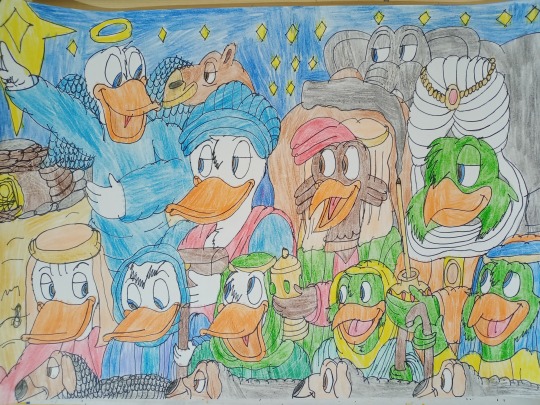


The Three Caballeros as the Three Wise Men along with their nephews as shepherds visiting the Savior - Duckverse in History - My Version
"And going into the house, they saw the child with Mary his mother, and they fell down and worshiped him. Then, opening their treasures, they offered him gifts, gold and frankincense and myrrh."(Matthew 2:11)
I haven't done Three Caballeros for a long time, but since the survey showed me to draw Three Caballeros, it will be.
Yes, in the Bible, more precisely in the New Testament and the Gospel according to Matthew, three wise men (according to some three kings) who are supposedly astrologers and magicians, went to visit the Holy Land to bring gifts to the Savior, that is, Jesus Christ who was born in Bethlehem, in stable, swaddled in a manger by his mother Mary. The three wise men brought them gold, incense, and myrrh. And those wise men are called Gaspar (or Caspar), Melchior, and Balthasar. The symbolism of the three is very well known so I used that for our heroes the Three Caballeros to be in those roles. Except in the Bible, they are not mentioned anywhere else, so it is uncertain who is who. Donald is Gaspar and wears gold, Panchito is Melchior and wears myrrh and Jose is Balthazar who wears incense, at least in my version or how they play the part. And they take it to the Savior Jesus Christ. I drew them wearing traditional clothing as worn at the time of Jesus' birth (1st century BC and 1st century AD) in Judea, in the Middle East. Donald is said to be from Persia, Panchito is from Yemen or Arabia, and Jose Carioca is from Ethiopia, which is where the three wise men supposedly came from.
Besides them, I also drew their nephews, Donald's nephews Huey, Dewey and Louie Duck and Jose's nephews Zico and Zeca Carioca as shepherds, that is, they play the role of shepherds. Luke's Gospel from the New Testament mentions that the angels told the shepherds to come and worship the Savior and the shepherds went to the Savior and worshiped him. So both Donald's and Jose's nephews will go and they are wearing shepherd's clothing as worn at the time (yes even though they are teenagers and these versions are from my version of the Quack Pack, they are still wearing the clothing of Jesus' time). There are also sheep and lambs from the Middle East accompanying them, and the wise men riding a camel and an elephant standing behind them. And there is the Angel Duck (to take from Donald's Better Self who is Donald's conscience and Donald's guardian angel) who leads them to the manger where the Lord Jesus Christ is. Glory to God who was born and who came to save us from our sins! Amen.
And I'm sorry if I offended you with something and it's not my intention to do so, this is just a drawing and some alternative and playing cosplay. Yes, the Three Wise Men are celebrated on January 6, ending the Christmas season, and with this I also marked the 800th anniversary of the Christmas Nativity tradition, which was introduced by the Catholic saint Francis of Assisi, the founder of the Franciscan order, who did it in 1223. Once again I wish everyone a Merry Christmas and a Happy New Year as well as a Happy Epiphany! And sorry about some things I did wrong in this drawing and just to say that I am a believer and I believe in God the Savior! And yes, I'm not the only one who drew the Three Caballeros as the Three Wise Men, there are already those drawings on the subject, I just did it in my own way.
I hope you like this drawing and feel free to like and reblog this!
#my fanart#the three caballeros#the legend of the three caballeros#duckverse#ducktales#quack pack#artists on tumblr#three wise men#nativity#history#history in duckverse#donald duck#jose carioca#panchito pistoles#huey dewey and louie#zico and zeca#zico and zeca carioca#huey dewey and louie duck#shepherds#jesus christ#bible#religion#christianity#disney ducks#huey duck#dewey duck#louie duck#ze carioca#José Carioca#duck comics
24 notes
·
View notes